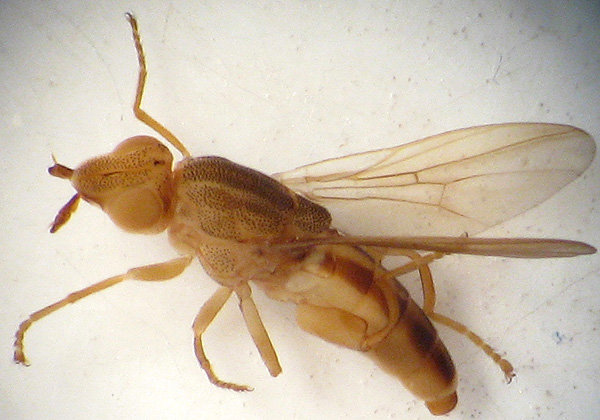Diptera.info :: Identification queries :: Diptera (adults)
|
Surprise again, it's a Chloropid not a Lauxaniid after all.
|
|
| Gordon |
Posted on 25-10-2008 13:27
|
|
Member Location: Lake Kerkini, Greece Posts: 1101 Joined: 02.01.08 |
This 7 mm long bristless beauty is from Wetland Kerkini, Greece. Lake side, 30 May to 5 June 2007. I am sure lots of people will know this instantly.
Gordon attached the following image:  [115.05Kb] Edited by Gordon on 25-10-2008 16:29 |
| Paul Beuk |
Posted on 25-10-2008 15:13
|
|
Super Administrator Location: Netherlands Posts: 19403 Joined: 11.05.04 |
Surprise: Trigonometopus frontalis of the Lauxaniidae!
Paul - - - - Paul Beuk on https://diptera.info |
| Gordon |
Posted on 25-10-2008 15:59
|
|
Member Location: Lake Kerkini, Greece Posts: 1101 Joined: 02.01.08 |
Surprise is correct. Lauxaniids are bristly all over, this aught to be called blablabla nuda, it has no bristles anywhere, no P, no F, no ocellar, no IV, none on the thorax just about, it looks like it had a close shave somewhere. But it was a nice surprise, so thanks. Gordon Edited by Gordon on 25-10-2008 16:03 |
| Stephane Lebrun |
Posted on 25-10-2008 16:02
|
|
Member Location: Le Havre, France Posts: 8248 Joined: 03.03.07 |
Sure ? In my opinion this is Platycephala cf. planifrons.
Stephane. |
|
|
|
| Xespok |
Posted on 25-10-2008 16:06
|
|
Member Location: Debrecen, Hungary Posts: 5551 Joined: 02.03.05 |
Yes, this is Platycephala.
Gabor Keresztes Japan Wildlife Gallery Carpathian Basin Wildlife Gallery |
| Gordon |
Posted on 25-10-2008 16:10
|
|
Member Location: Lake Kerkini, Greece Posts: 1101 Joined: 02.01.08 |
I'm not sure of anything, but both the species mentioned would be new records for Greece according to Fauna Eurpaea, so there is bound to be good news in time. |
| Gordon |
Posted on 25-10-2008 16:24
|
|
Member Location: Lake Kerkini, Greece Posts: 1101 Joined: 02.01.08 |
I have been for a walk to the gallery room, and there I found two photos of Platycephala planifrons that look remarkably like this, one of them at least was determined by Paul Beuk. I also found a photo of Trigonometopus frontalis, very similar, but with bristles and maybe some spots on the wings and much less obviously polkadot elsewhere, so I am going with the Chloropid. Edited by Gordon on 25-10-2008 16:26 |
| jorgemotalmeida |
Posted on 25-10-2008 17:09
|
|
Member Location: Viseu - PORTUGAL Posts: 9296 Joined: 05.06.06 |
and this is just hilarious: http://zipcodezoo...lanifrons/ maybe some binge drinking? See carefully... and you will know why. Of course this is clearly a chloropid.  But it is nice to know that there are some lauxaniids can resemble a chloropid! But it is nice to know that there are some lauxaniids can resemble a chloropid! |
| Paul Beuk |
Posted on 25-10-2008 20:27
|
|
Super Administrator Location: Netherlands Posts: 19403 Joined: 11.05.04 |
Oops...
Paul - - - - Paul Beuk on https://diptera.info |
| Gordon |
Posted on 26-10-2008 05:41
|
|
Member Location: Lake Kerkini, Greece Posts: 1101 Joined: 02.01.08 |
So according to Zipcode Zoo what I have caught 130 km from the nearest sea is a fly that thinks its a dung beetle and lives approximately 14 metres from the seashore. How did you ever find this out Jorge. Gordon |
| von Tschirnhaus |
Posted on 18-05-2013 17:40
|
|
Member Location: Bielefeld, Germany Posts: 454 Joined: 04.11.07 |
Platycephala planifrons (Fabricius, 1798), Chloropidae. Species characters: The many punctures on the frontal triangle and scutum are dark and identical, the length of the projecting frons nearly equals the eye-length, and the shape of the 3rd antennal segment is typical. The different species are not always easy to distinguish and identification should be confirmed by checking the male genitalia after the article of Beschovski (1980): Acta zoologica bulgarica 15: 72-76. Larvae develop in reed stems resulting in the dye-off of the whole stem and all leaves above the single larva. |
| Gordon |
Posted on 24-06-2013 16:58
|
|
Member Location: Lake Kerkini, Greece Posts: 1101 Joined: 02.01.08 |
Thanks Michael. Gordon |
| Jump to Forum: |













